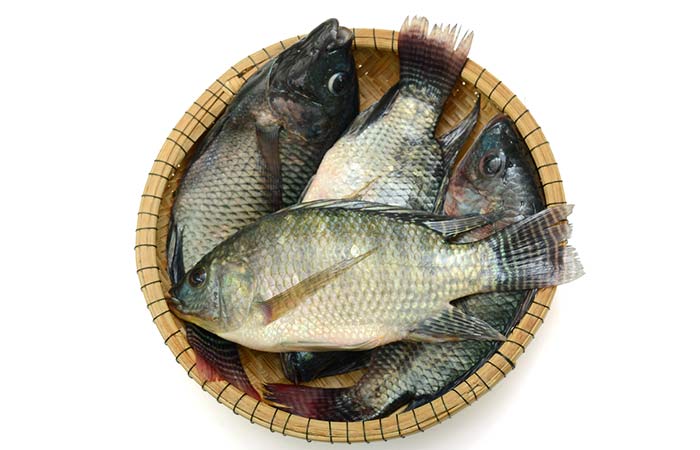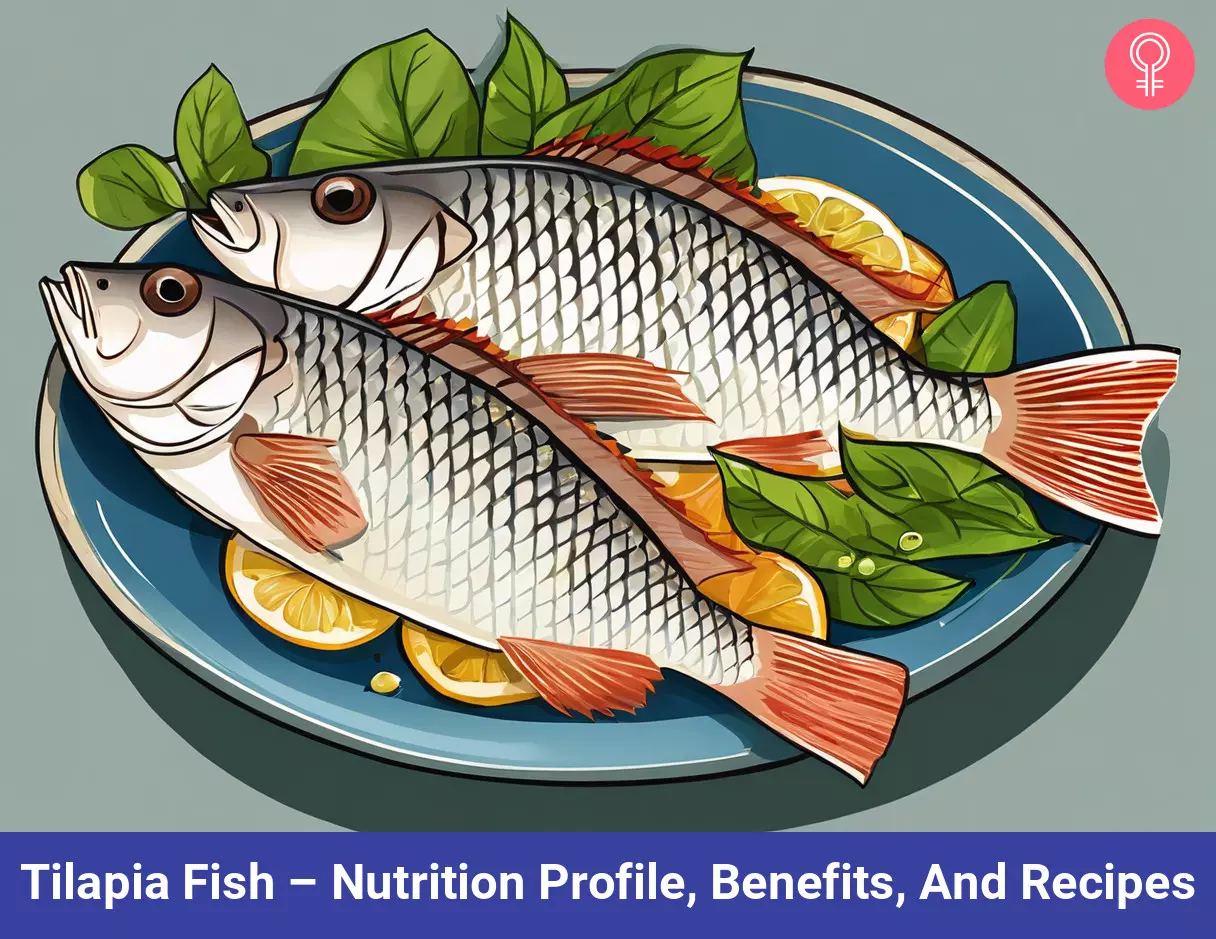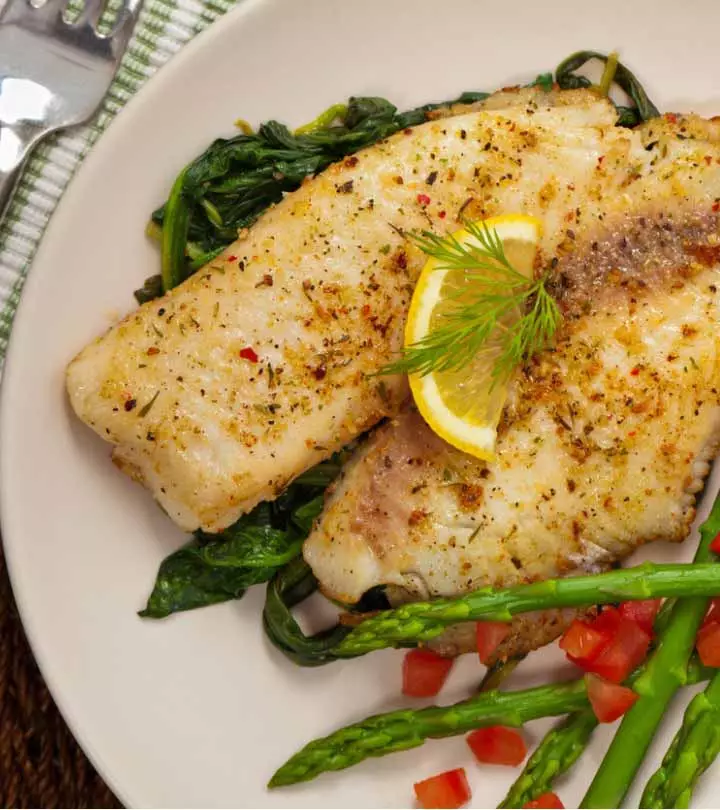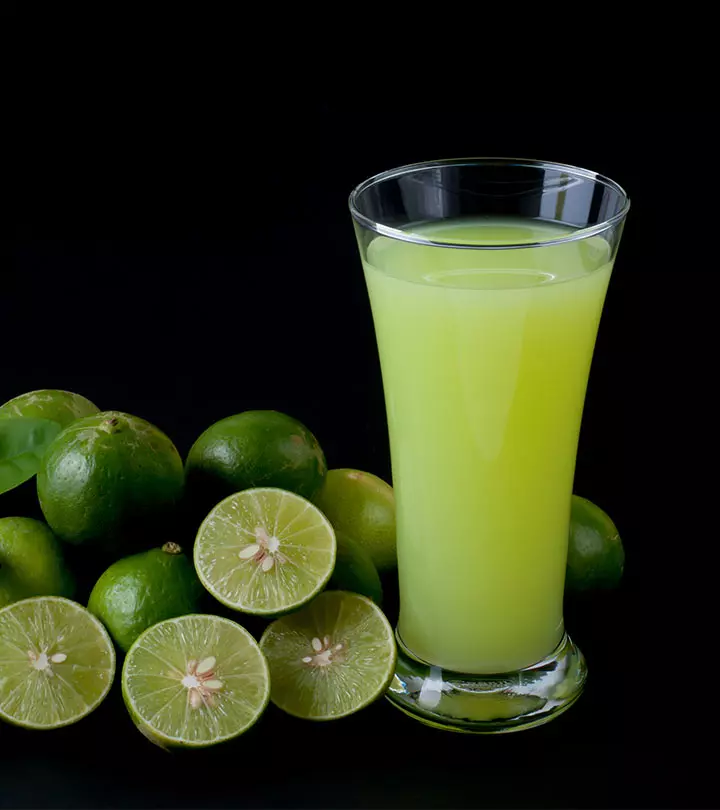Tilapia Fish – Nutrient Profile, Safety, Benefits, & Recipes
Relish some scrumptious freshwater fish dishes and become healthier at the same time.

Image: Shutterstock
Tilapia is an inexpensive source of protein (1). The many benefits of tilapia fish can be attributed to its rich nutritional profile. It is the second most farmed fish in the world. It had originated in the Middle East and Africa and achieved global popularity when scientists revealed its many health benefits. Culturing tilapia fish for mass production was also easy as it could grow in any condition. However, concerns about heavy metal poisoning have surfaced recently. Here, we bring you the truth. Read on to know the science-backed benefits of consuming tilapia fish, its recipes, and if consuming the fish is safe.

 Trivia
TriviaIn This Article
Tilapia – A Brief Introduction

Tilapia belongs to the cichlid family. It is a freshwater fish that grows in ponds, rivers, lakes, and shallow streams at warm temperatures and has a mild taste. It resembles a sunfish and has lateral stripes and a long dorsal fin.
There are four commercial species of tilapia – Mozambique tilapia, Blue tilapia, Red tilapia, and Nile tilapia. The history of Nile tilapia can be traced back to ancient Egyptian culture.
 Quick Tip
Quick TipInterestingly, tilapia was considered the symbol of rebirth. These days, it is cultured in farms, and hybrid fish are being produced to meet the increasing market demands. And they are often injected with growth hormones that may have a detrimental effect on humans. Let’s consider all the pros and cons of Tilapia fish to come to a conclusion. Let’s begin with the nutrition facts.
Key Takeaways
- Tilapia, a freshwater fish, is rich in protein and many nutrients.
- Tilapia are rich in omega-3s, which improve neurological function and help the brain function better.
- Antioxidants and vitamin E in tilapia brighten and enhance your skin tone and shield the skin from photodamage.
- Since tilapia fish are farm-raised, they raise the risk of cancer and mercury poisoning. Therefore, always buy them from a trusted source and seek medical advice immediately.
Tilapia Nutrition Facts
Tilapia fish is loaded with protein, low in calories, and is a good source of vitamins and minerals. Take a look at its nutritional profile.
1 oz tilapia contains
- Calories – 36
- Protein – 7.3g
- Total Fat – 0.7g
- Polyunsaturated Fat – 0.11g
- Carbs – 0 grams
- Calcium – 3.9mg
- Magnesium – 9.5mg
- Potassium – 106mg
- Selenium – 15.2mg
- Vitamin E – 0.2mg
- Niacin – 1.3mg
- Folate – 1.7mcg
- Vitamin B12 – 0.5 mcg
- Pantothenic acid – 0.2mg
Tilapia’s selenium content is said to aid the immune system while its omega-3 content is recommended to improve vision health. So, is tilapia good for you? Is tilapai healthy? Let’s find out in the next section.
8 Health Benefits Of Tilapia
1. Good For The Bones
Tilapia fish is good for your bones. It contains nutrients like vitamin D and minerals such as calcium and phosphorus that are needed for bone growth and bone health maintenance. A few recent studies have shown that tilapia fish collagen type 1 is highly useful in regenerative medicine (2). It has shown promising results in aiding bone cell regeneration in the laboratory and can also be used as a scaffolding biomaterial in the dental field (3), (4).
2. Prevents Diseases Like Cancer
Like several other kinds of fish, tilapia contains selenium and antioxidants that fight cancer and treat heart-related diseases (5). Selenium reduces the free radical activity and makes you less prone to oxidative stress (6), (7). It inhibits the mutation of healthy cells to cancerous ones(8). Moreover, scientists have found that an antimicrobial peptide (short amino acid chain), hepcidin 1-5, has anti-inflammatory effects and can be used as a novel treatment for cancer (9).
3. Good For The Brain

Consuming tilapia can boost brain function as it contains omega-3s in abundance that increase neurological function and have neuroprotective properties (10). Tilapia is also loaded with selenium that is proven to protect the brain from various diseases like Alzheimer’si A progressive neurological disease that affects mental functions, such as memory and thought due to the degeneration of brain cells. , Parkinson’si A central nervous system disorder that causes uncontrollable tremor-like movements due to reduced dopamine levels. , and epilepsy (11). It increases the flow of oxygen to the brain, which helps in balancing fluids throughout the body. It not only deposits nutrients into the system but also boosts mental clarity.
4. Protects The Heart
Another health benefit of tilapia is that it improves your heart health. With zero carb content, it may also help with cholesterol level and diabetes management. But mind you, it is wild tilapia that does this not the aquaculture tilapia that’s fed with chemicals and generally has an imbalanced omega-3 and omega-6 fatty acid ratio. Wild tilapias have more omega-3 fatty acids compared to the cultured ones (12). According to a recent study, omega-3s can help reduce high blood pressure and prevent heart attacks, strokes, and atherosclerosisi A build-up of fats along the walls of arteries that makes them grow narrower and blocks blood flow, increasing the risk of heart disease. (13) (14).
5. Fights Aging
Tilapia contains antioxidants and vitamin E that improve skin health.
They improve your complexion and make your skin radiant. Both the vitamins are potent antioxidants, which means they help scavenge the harmful free radicals, thereby helping reduce inflammation and stress. They also protect the skin from photodamage (skin damage caused by harmful UV rays). As a result your skin, bones, organs, and cells remain active and young (15).
6. Weight Loss
Tilapia, in conjunction with proper diet and exercise, can help boost weight loss efforts due to its high protein and low fat. It is very high in protein and very low in calories. It could be a great way to reduce the calorie intake and also provide your body with the nutrients it needs to function properly. It can also be a dietary option for those who are trying to get back into shape.
7. For Thyroid Patients
Tilapia contains selenium that plays an important role in the regulation of the thyroid gland and improves the hormonal functions as well (16). Regular functioning of the thyroid gland will make sure your metabolism is boosted and prevent weight gain/loss or any other disease related to a malfunctioning thyroid.
8. Heals Wounds
Scientists have found that marine collagen peptide from Nile tilapia showed significant progress in closing scratch wounds and flesh wounds in laboratory animals (17).
These are the mighty eight different ways in which tilapia fish benefits your health. You might want to add it to your diet right away! However, there are a few preparation tips that can help you harvest the most benefits and flavors from this fish. Learn more in the next section.
Preparation Tips For Tilapia Fish
Always prioritize freshness when selecting tilapia for consumption. Fresh tilapias should have a mild, ocean-like scent, clear eyes, and firm flesh.
If you opt for frozen tilapia, ensure it is thawed completely and gently before cooking it. Thawing it in the refrigerator overnight is the gentlest method, as it allows the fish to thaw slowly and evenly. Avoid thawing it at room temperature or using hot water, as this can lead to uneven thawing and bacterial growth.
Following these tips can ensure that your tilapia is fresh and flavorful, resulting in a delicious meal.
But how to prepare it? Here are a few Tilapia fish recipes to give you the general idea.
1. Baked Tilapia

- Prep Time: 10 mins
- Cooking Time: 30 mins
- Total Time: 40 mins
- Serves: 2
Ingredients
- 4 oz tilapia filets
- 2 teaspoons olive oil
- 1 teaspoon unsalted butter
- 1 tablespoon lemon juice
- 1 cup broccoli
- 1 cup chopped carrot
- 1 teaspoon chili flakes
- Salt to taste
How To Prepare
- Preheat the oven to 135o F.
- Line the baking tray with parchment paper.
- Toss the tilapia filets and veggies with olive oil, butter, lemon juice, salt, and chili flakes.
- Transfer them to the baking tray.
- Cover it and bake for 20-30 minutes.
2. Lemon Garlic Tilapia

- Prep Time: 10 mins
- Cooking Time: 30 mins
- Total Time: 40 mins
- Serves: 2
Ingredients
- 4 oz tilapia fillets
- 1 teaspoon butter
- 1 teaspoon finely chopped garlic
- 2 tablespoons lemon juice
- 1 tablespoon chopped parsley
- Salt to taste
- ½ teaspoon pepper
How To Prepare
- Preheat the oven to 135oF.
- Line the baking tray with parchment paper.
- Toss the tilapia fillets in lemon juice, salt, pepper, and garlic.
- Drizzle butter on top and top with parsley.
- Transfer the fillets to the baking tray.
- Cover it and bake for 20-30 minutes.
3. Tilapia Taco

- Prep Time: 10 mins
- Cooking Time: 30 mins
- Total Time: 40 mins
- Serves: 2
Ingredients
- 4 corn tortillas
- 4 tilapia fillets
- 2 tablespoons lime juice
- Salt to taste
- ½ teaspoon pepper
- ¼ teaspoon red chili flakes
- 1 teaspoon garlic powder
- ½ cup shredded cabbage
- ½ avocado, chopped
- 1 tomato, chopped
- ¼ cup chopped cucumber
- ½ cup grated cheese
- ½ cup yogurt
- Cilantro for garnish
- Cooking spray
How To Prepare
- Rub the tilapia fillets with lime juice, salt, pepper, and garlic powder.
- Spray the fillets with cooking spray and grill them, 5 minutes on each side.
- Heat the tortillas on a skillet.
- In the meanwhile, blend yogurt, cilantro, and chili flakes into a smooth sauce.
- Divide the grilled tilapia on the tortillas.
- Add salsa, cabbage, cucumber, avocado, and tomato.
- Top with the yogurt sauce and garnish with cilantro.
There are many other recipes you can look for online. Adeyinka, a food blogger, shared how she adds tilapia fish to numerous dishes. Talking about one of her favorite dishes, she writes, “ I love catfish a lot,especially served with jollofrice (you know it has to be Nigerian jollofrice…) I made sure I ate it at least once a week while I lived in Nigeria. It was one of the foods I missed the most when I moved to America and I just had to fix that (i).”
One main question remains unanswered – is consuming tilapia fish safe? Find out next.
Is It Safe To Consume Tilapia?
Is tilapia healthy? Yes, if it is wild-caught tilapia. But if it is farm-raised, there are many concerns, and you should be aware of them and make an informed decision while buying or ordering tilapia. Here’s what you should know.
- Risk Of Arsenic Poisoning
Sad but true. Scientists evaluated farmed tilapia fish in Taiwan, which were found to harbor arsenic (18). Arsenic is a cancer-causing metallogen, and chronic exposure to arsenic increases the risk of cancer (19).
- Risk Of Mercury Poisoning
You may have heard about mercury poisoning related to tilapia or fish in general. It is true. Scientists have found that both freshwater and aquaculture tilapia can bioaccumulate mercury. However, freshwater tilapia poses about 5% less mortality risk when compared to the mercury poisoning caused by farmed tilapia (20).
- Can Increase Inflammation
Tilapia is also known as aquatic chicken because of its protein content and numerous health benefits. But farmed tilapia can lead to an increase in inflammation in the body. This, in turn, can lead to arthritisi A common disorder that causes inflammation of one or more joints allowing for a reduced range of motion. , weight gain, and heart disease (21).
- Imbalanced Omega-3 and Omega-6 Ratio
The ideal ratio of omega-3 and omega-6 fatty acids is 1:1. But in farmed tilapia, the ratio is 2:1 or 4:1, which may cause many diseases, including hypertensioni A condition that raises blood pressure above normal and increases the risk of stroke and heart disease. and heart diseases (22).
- Risk Of Cancer
Farmed fish are exposed to heavy metals that finally enter the human system. Consuming too many of them can lead to mutation in the DNA and cancer (23). Moreover, not all farmed fish are not grown in healthy and hygienic culture conditions, thereby leading to many other diseases.
- PCB And Pesticide
Researchers have found that tilapia grown in farms contain many pollutants, such as polychlorinated biphenyls (PCBs), organochlorine (OC), organophosphorus (OPs), hexachlorobenzene (HCB), and trifluralin pesticides (24).
We have both its benefits and risks before us. But how does tilapia fish fare when compared to salmon? Let us wind up the article by comparing the two. Check out the next section.
Tilapia Vs. Salmon: Which Is Better?
Both tilapia and salmon have similar amounts of protein. However, their major difference lies in their caloric content. 100 g of salmon contains 208 calories, which is much higher than the 96 calories of tilapia. The latter’s low caloric content can be attributed to its low-fat content (1.7 g) compared to salmon’s 13.4 g of total fat (25), (1). This makes tilapia a better source of lean protein, which is ideal for those who want to lose weight. That said, both the fish varieties are nutritious and are rich in nutrients, such as niacin and magnesium. You can choose either depending on your personal preference and dietary goals.
Tilapia is a freshwater fish with a mild flavor. It is inexpensive and is a great source of protein. The many benefits of tilapia can be attributed to its rich nutritional profile and low calorific values. The intake of tilapia is good for bone growth and maintenance. It also reduces cancer risk, improves brain health, protects the heart, fights aging signs, and helps with weight management. You can prepare many delicious recipes with tilapia. However, farm-raised fish may cause arsenic and mercury poisoning and increase inflammation. Hence, buy them from a trusted source and consult your doctor in case of any emergencies.
Frequently Asked Questions
Is tilapia healthier than chicken?
Both tilapia and chicken are great sources of lean protein. However, tilapia contains more omega-3 fats than chicken.
Can you eat tilapia everyday?
No, the FDA recommends consumption of 8 to 12 ounces of tilapia per week, which roughly translates to two to three times per week.
Is tilapia good for your liver?
Yes, tilapia is an oily fish and its moderate consumption may help lower the risks of fatty liver disease (26), (27).
Illustration: Tilapia Fish – Nutrition Profile, Benefits, And Recipes

Image: Stable Diffusion/StyleCraze Design Team
References
Articles on StyleCraze are backed by verified information from peer-reviewed and academic research papers, reputed organizations, research institutions, and medical associations to ensure accuracy and relevance. Read our editorial policy to learn more.
- Fish, tilapia, raw
https://fdc.nal.usda.gov/fdc-app.html#/food-details/175176/nutrients - Biological Safety of Fish (Tilapia) Collagen, Biomed Research International, US National Library of Medicine, National Institutes of Health.
https://www.ncbi.nlm.nih.gov/pmc/articles/PMC3997882/ - Hydrolyzed tilapia fish collagen induces osteogenic differentiation of human periodontal ligament cells. Biomedical Materials, US National Library of Medicine, National Institutes of Health.
https://pubmed.ncbi.nlm.nih.gov/26657831/ - Effect of type I collagen derived from tilapia scale on odontoblast-like cells. Tissue Engineering and Regenerative Medicine, Korean Tissue Engineering and Regenerative Medicine Society.
https://link.springer.com/article/10.1007/s13770-014-0114-8 - Is Selenium a Potential Treatment for Cancer Metastasis? Nutrients, US National Library of Medicine, National Institutes of Health.
https://www.ncbi.nlm.nih.gov/pmc/articles/PMC3705340/ - Selenium: its role as antioxidant in human health, Environmental Health and Preventive Medicine, US National Library of Medicine, National Institutes of Health.
https://www.ncbi.nlm.nih.gov/pmc/articles/PMC2698273/ - Influence of the forms and levels of dietary selenium on antioxidant status and oxidative stress-related parameters in rainbow trout (Oncorhynchus mykiss) fry. The British Journal of Nutrition, US National Library of Medicine, National Institutes of Health.
https://pubmed.ncbi.nlm.nih.gov/25990817/ - The role of selenoproteins in cancer. Revista da Associação Médica Brasileira, US National Library of Medicine, National Institutes of Health.
https://pubmed.ncbi.nlm.nih.gov/20835649/ - Tilapia (Oreochromis mossambicus) antimicrobial peptide, hepcidin 1-5, shows antitumor activity in cancer cells. Peptides, US National Library of Medicine, National Institutes of Health.
https://pubmed.ncbi.nlm.nih.gov/21093514/ - Long-chain omega-3 fatty acids and the brain: a review of the independent and shared effects of EPA, DPA and DHA, Frontiers in Aging Neuroscience, US National Library of Medicine, National Institutes of Health.
https://www.ncbi.nlm.nih.gov/pmc/articles/PMC4404917/ - Importance of selenium and selenoprotein for brain function: From antioxidant protection to neuronal signalling. Journal of Inorganic Biochemistry, US National Library of Medicine, National Institutes of Health.
https://pubmed.ncbi.nlm.nih.gov/26398431/ - Omega-6 (n-6) and omega-3 (n-3) fatty acids in tilapia and human health: a review. International Journal of Food Sciences and Nutrition, US National Library of Medicine, National Institutes of Health.
https://pubmed.ncbi.nlm.nih.gov/19757249/ - Omega-3 fatty acids and cardiovascular disease. European Review for Medical and Pharmacological Sciences, US National Library of Medicine, National Institutes of Health.
https://pubmed.ncbi.nlm.nih.gov/25720716/ - Beneficial effects of omega-3 fatty acids in cardiovascular disease. The Journal of Small Animal Practice, US National Library of Medicine, National Institutes of Health.
https://pubmed.ncbi.nlm.nih.gov/20673293/ - Vitamin E in dermatology, Indian Dermatology Online Journal, US National Library of Medicine, National Institutes of Health.
https://www.ncbi.nlm.nih.gov/pmc/articles/PMC4976416/ - Selenium and Thyroid Disease: From Pathophysiology to Treatment, International Journal of Endocrinology, US National Library of Medicine, National Institutes of Health.
https://www.ncbi.nlm.nih.gov/pmc/articles/PMC5307254/ - Marine Collagen Peptides from the Skin of Nile Tilapia (Oreochromis niloticus): Characterization and Wound Healing Evaluation, Marine Drugs, US National Library of Medicine, National Institutes of Health.
https://www.ncbi.nlm.nih.gov/pmc/articles/PMC5408248/ - Health risks for human intake of aquacultural fish: Arsenic bioaccumulation and contamination. Journal of environmental science and health. Part A, Toxic/hazardous substances & environmental engineering, US National Library of Medicine, National Institutes of Health.
https://pubmed.ncbi.nlm.nih.gov/21879859/ - Arsenic Exposure and the Induction of Human Cancers, Journal of Toxicology, US National Library of Medicine, National Institutes of Health.
https://www.ncbi.nlm.nih.gov/pmc/articles/PMC3235889/ - Assessing exposure risks for freshwater tilapia species posed by mercury and methylmercury. Ecotoxicology, US National Library of Medicine, National Institutes of Health.
https://pubmed.ncbi.nlm.nih.gov/27207496/ - The content of favorable and unfavorable polyunsaturated fatty acids found in commonly eaten fish. Journal of the American Dietetic Association, US National Library of Medicine, National Institutes of Health.
https://pubmed.ncbi.nlm.nih.gov/18589026/ - Omega-6 (n-6) and omega-3 (n-3) fatty acids in tilapia and human health: a review. International Journal of Food Sciences and Nutrition, US National Library of Medicine, National Institutes of Health.
https://pubmed.ncbi.nlm.nih.gov/19757249/ - Spatial analysis of potential carcinogenic risks associated with ingesting arsenic in aquacultural tilapia (Oreochromis mossambicus) in blackfoot disease hyperendemic areas. Environmental Science and Technology, US National Library of Medicine, National Institutes of Health.
https://pubmed.ncbi.nlm.nih.gov/16568791/ - Multi pesticide and PCB residues in Nile tilapia and catfish in Assiut city, Egypt. The Science of the Total Environment, US National Library of Medicine, National Institutes of Health.
https://pubmed.ncbi.nlm.nih.gov/23911921/ - Fish, salmon, Atlantic, farmed, raw
https://fdc.nal.usda.gov/fdc-app.html#/food-details/175167/nutrients - Oily fish, coffee and walnuts: Dietary treatment for nonalcoholic fatty liver disease. World Journal of Gastroentology, US National Library of Medicine, National Institutes of Health.
https://www.ncbi.nlm.nih.gov/pmc/articles/PMC4588084/ - Food groups and the likelihood of non-alcoholic fatty liver disease: a systematic review and meta-analysis. The British Journal of Nutrition, US National Library of Medicine, National Institutes of Health.
https://www.ncbi.nlm.nih.gov/pmc/articles/PMC7512147/ .
Read full bio of Dr.Jacob Wilson
Read full bio of Arshiya Syeda
Read full bio of Payal Karnik



























Community Experiences
Join the conversation and become a part of our empowering community! Share your stories, experiences, and insights to connect with other beauty, lifestyle, and health enthusiasts.